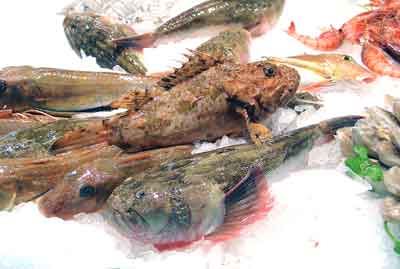
Stargazer, a fish common in the Mediterranean. Useful in soups and stews and can be fried. The sharp, spiny dorsal fins must be removed before cooking. The eyes are set right on top of the head, gazing skyward, hence the English name for this fish.
Long coriander. Stinkweed. A herb widely used in seasoning and marinating in the Caribbean. It is also used extensively in Thailand, India, Vietnam, and other parts of Asia as a culinary herb. This variety of coriander dries well, retaining good color and flavor, making it valuable in the dried herb industry. It is sometimes used as a substitute for cilantro, but it has a much stronger taste. This name sometimes leads to confusion with coriander.

Smelt. A fish of the salmon family often served tossed in flour and fried. Fresh from the water, they are said to smell like cucumber.

Scad, jack or horse mackerel. The tough part near the tail must be removed before cooking. Fish which have a firm tail section and bright eyes are the ones to select. They are at their best from spring to autumn (US: fall). In Japan they are used for sashimi or sushi and may also be grilled, simmered or deep-fried.
Salt cod mashed with garlic, olive oil, milk or cream and truffles into a thick, tasty purée, served warm.
False morel mushrooms. They are deadly poisonous if not cooked, closely resembling real morel mushrooms, being wrinkled and brown in the same way. However, morel mushrooms are symmetrical while false morels are irregular in shape and look like a brown brain, while true morels are more like a sponge. True morels have hollow stems while those of false morels are solid. Be careful to check each of these features before attempting to eat one. They have a fine flavour and are generally parboiled. They are popular in Nordic countries and in Finland especially.
A kind of yoghurt, clabbered milk or longmilk with a stringy consistency; milk, mixed with a little soured cream (US: cultured sour cream), which has been left to stand in a warm place until it has set. Lactic acid bacteria act on the milk. There is also a fungus present, Geotrichum candidum, which gives a smooth velvety surface to it. It is usually served with sugar, sprinkled with ginger and cinnamon and present with knäckebröd or ginger snaps.